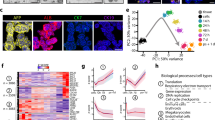Abstract
IT has been known for many years that in laboratory animals, such as the rat, partial hepatectomy is followed by liver regeneration. In recent years it has been generally accepted that this response is initiated by some sort of humoral mechanism1. This view was, however, originally based on parabiotic and serum injection experiments, the validity of which has been contested. We have therefore been led to re-examine the alternative and much older ‘blood-flow’ theory3. This postulates that after partial hepatectomy the remaining liver fragment acquires a much more generous blood supply, since it has to accommodate portal vein blood previously destined for the excised lobes. It is this over-generous blood supply which is said to act as the stimulus to hyperplasia. The strongest evidence in favour of this theory was derived from experiments on domestic fowls, by taking advantage of the anastomosis between the post-caval and portal veins through the coccygeo-mesenteric vein. It is therefore possible to increase portal blood flow by simple ligation of the postcaval vein between the kidneys and the liver. According to the ‘blood-flow’ theory this should itself cause hyperplasia of the liver. Furthermore, the ‘blood-flow’ theory would predict that, in the fowl, partial hepatectomy would not be followed by liver regeneration, since the blood which would normally be accommodated by the missing lobes could instead return to the heart via the anastomosis. It was claimed that both these theoretical predictions were fulfilled experimentally4. Since the number of fowls used in these original experiments was small, and since the criteria of liver growth were very crude, it seemed worthwhile to repeat them in an improved form using mitotic frequency as an index of liver growth. For this purpose we have used 26-week-old pullets of the “Sussex Legbar” strain weighing about 1,200 g. For both operations the fowls were anaesthetized lightly with intravenous ‘Nembutal’, and anaesthesia completed with ether. In the partial hepatectomy the entire left lobe of the liver was removed through an incision in the left side parallel to the edge of the sternum and 1 cm above it. Ligation of the postcaval vein was performed through an incision in the right flank4.
This is a preview of subscription content, access via your institution
Access options
Subscribe to this journal
Receive 51 print issues and online access
$199.00 per year
only $3.90 per issue
Buy this article
- Purchase on Springer Link
- Instant access to full article PDF
Prices may be subject to local taxes which are calculated during checkout
Similar content being viewed by others
References
Bucher, N. L. R., Intern. Rev. Cytol., 15, 245 (1963).
Leong, G. F., Grisham, J. W., Hole, B. V., and Albright, M. L., Cancer Res., 24, 1496 (1964).
Mann, F. C., J. Mt. Sinai Hosp., 11, 65 (1944).
Higgins, G. M., Mann, F. C., and Priestley, J. T., Arch. Path. (Lab. Med.), 14, 491 (1932).
Sigel, B., Arch. Surg. (Chicago), 87, 788 (1963).
Markowitz, J., Experimental Surgery (Baillière, Tindall and Cox, London, 1954).
Author information
Authors and Affiliations
Rights and permissions
About this article
Cite this article
THOMSON, R., CLARKE, A. Role of Portal Blood Supply in Liver Regeneration. Nature 208, 392–393 (1965). https://doi.org/10.1038/208392a0
Issue Date:
DOI: https://doi.org/10.1038/208392a0
This article is cited by
-
A critical appraisal of the hemodynamic signal driving liver regeneration
Langenbeck's Archives of Surgery (2012)
-
NO counterbalances HO-1 overexpression-induced acceleration of hepatocyte proliferation in mice
Laboratory Investigation (2007)
-
Stimulation of cell division in ectopic liver tissue following partial removal of the lung
Experientia (1977)
Comments
By submitting a comment you agree to abide by our Terms and Community Guidelines. If you find something abusive or that does not comply with our terms or guidelines please flag it as inappropriate.



